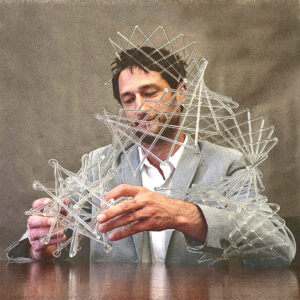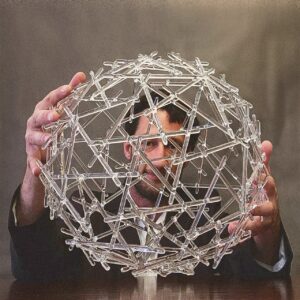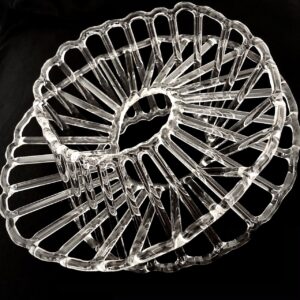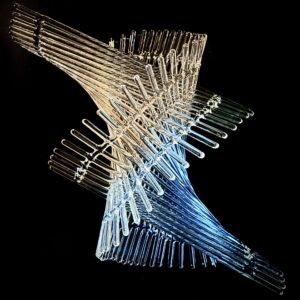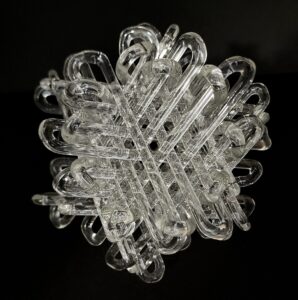Tell us about yourself.
Anduriel Widmark, born in 1987, is an American glass artist from Denver, Colorado. In 2010, he received a Bachelors of Fine Arts degree, with a concentration in painting, from Metropolitan State University of Denver. Throughout childhood, Anduriel was attracted to the elegance and beauty in numbers and over time has found ways to explore his interest in mathematics using art. Glass sculptures and oil paintings materialize abstract geometric patterns with bright dynamic shapes and interweaving lines. He frequently exhibits internationally, including at the Bridges Math Art conferences, Joint Mathematics Meetings and the Mathematical Association of America. Anduriel’s work plays with structures and their properties to develop new perspectives, using math to explore and celebrate the patterns that create our world.
What draws you to the material you work with?
Melting glass is an alluring process that still captivates me every time I get into the studio. Transforming something with fire is like bringing something to life, and it’s exciting when it feels like it talks back to you. Each medium offers a unique way of seeing the universe. For me, glass has been a gateway to understanding the world, not just from a material science perspective but also as a lens for viewing social and historical changes. It’s been a way to learn about history, track technological developments, and share culture. Glass has a way of capturing you under its spell, and it just doesn’t seem to let go.
What themes do you pursue in your work, and why have you chosen the processes that you use in your work?
My artistic practice frequently returns to themes of pattern, story, and abstraction. I enjoy the precision and technical challenges that come with exploring mathematical concepts in glass. Working with borosilicate glass, which is manufactured to exacting tolerances, is ideal for creating geometric designs that require precision and allow for the construction of structures with clean lines. One of the mathematical concepts I explore in my work is polystix (symmetric arrangements of non-intersecting rods) which are used as the basis for an ongoing series of topologically complex knots. I also enjoy playing with other shapes such as Möbius strips, hyperbolic paraboloids, glass helicoids, intersecting polyhedral sculptures, and geodesics. Engaging with these shapes and symmetry not only offers challenging puzzles but also provides a fun way to create beautiful objects.
What is your dream project?
So, the ‘Dream Project’ we’ve been working with focuses on using the latest machine learning algorithms to interpret brainwaves during dreams and reproduce them as short films. These are then superimposed onto contextually appropriate comedic scenarios in real-time, using augmented reality and holographic projections. This situational dream awareness comedy generator is completely imaginary though, and not related to reality in any tangible way. Dreaming about new projects can be a fun game. I tend to dream about different ways of seeing the world, and then try to find ways to anchor those perspectives and insights to in a physical form before they slip away.
Why are you a member of GAS?
As a member of the Glass Art Society, I stay connected to some of the best artists and producers in the industry. The resources provided by this community help bring the glass world together and promote a helpful sharing of information and techniques. I enjoy staying current and having access to a community filled with amazingly talented artists. GAS is an invaluable resource for solving technical challenges or gaining contextual insights. I am always happy to connect with fellow glass artists and welcome anyone seeking advice or wishing to share ideas to reach out. Let’s keep the creativity flowing.

